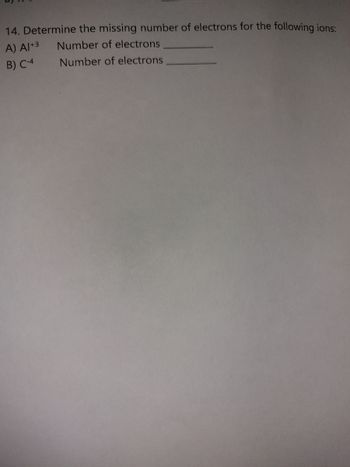
Chemistry
10th Edition
ISBN: 9781305957404
Author: Steven S. Zumdahl, Susan A. Zumdahl, Donald J. DeCoste
Publisher: Cengage Learning
expand_more
expand_more
format_list_bulleted
Concept explainers
Question

Transcribed Image Text:14. Determine the missing number of electrons for the following ions:
A) A1+3
Number of electrons
B) C-4
Number of electrons
Expert Solution
This question has been solved!
Explore an expertly crafted, step-by-step solution for a thorough understanding of key concepts.
Step by stepSolved in 3 steps

Knowledge Booster
Learn more about
Need a deep-dive on the concept behind this application? Look no further. Learn more about this topic, chemistry and related others by exploring similar questions and additional content below.Similar questions
- Boxes 1-2arrow_forwardHow do I find out how many protons an atom has?arrow_forwardComplete the table below, using the diagram of an atom shown at right. Properties of subatomic particles On approximate charge (in multiples of e) location name symbol mass on diagram (amu) electron (choose one) v (choose one) v proton (choose one) v(choose one) ♥ -1 0.0005 B OOOarrow_forward
- 1-Complete the table below. some binary molecular compounds name chemical formula nitrogen trifluoride chlorine monofluoride dinitrogen tetrafluoride carbon tetrafluoride 2-Fill in the missing information: symbol atom or ion?check all that apply number of protons number of electrons Ar ___neutral atom ___ cation ___anion As3- ___neutral atom ___ cation ___anion Be2+ ___neutral atom ___ cation ___anion 3-The names and chemical formulae of some chemical compounds are written in the first two columns of the table below. Each compound is soluble in water. Imagine that a few tenths of a mole of each compound is dissolved in a liter of water. Then, write down in the third column of the table the chemical formula of the major chemical species that will be present in this…arrow_forwardComplete the table below, using the diagram of an atom shown at right. name symbol proton electron: 0 Properties of subatomic particles approximate mass (amu) (choose one) (choose one) (choose one) charge (in multiples of e) 0 0 0 location on diagram (choose one) (choose one) (choose one) Xarrow_forward1)Fill in the correct subscript in the formula for the ionic compound which contains Li + cation and (OH) - anion. Li ____ (OH) _____ 2)Fill in the correct subscript in the formula for the ionic compound which contains Zn 2+ cation and (OH) - anion. Zn ___(OH) ____arrow_forward
- What does an atom gain or lose when ions are produced? A)protons B)neutrons C)electronsarrow_forward4. Make a table like the one below to identify three examples of stable atoms and ions. Include 1 with neutral charge, 1 with a positive charge, and 1 with a negative charge. Table 2 What is in your Capture and paste your atom or ion Is it a neutral atom, positive ion, or negative ion? explain why What is atom or ion? (Stable only) # of protons: 1 # of neutrons: # of electrons: # of protons: # of neutrons: the charge? # of electrons: # of protons: # of neutrons: 3 # of electrons:arrow_forwardFor the first and third blank the options are could be or cannot be. For the second and fourth blank the options are definite proportions or multiple proportions.arrow_forward
- 3. Which one of the following is a monoatomic element? a) oxygen b) iodine c) argon d). nitrogenarrow_forward1) A molecule is composed of two or more of the same or different elements. A) true B) false An atom with 3 protons, 3 electrons, and 4 neutrons has an atomic number of which of the following? A) lithium B) beryllium C) helium 3) what is the valence number of carbon? A) 4 B) 6 C) 2 D) 12arrow_forwardPlease complete the following question. 2arrow_forward
arrow_back_ios
SEE MORE QUESTIONS
arrow_forward_ios
Recommended textbooks for you
 ChemistryChemistryISBN:9781305957404Author:Steven S. Zumdahl, Susan A. Zumdahl, Donald J. DeCostePublisher:Cengage Learning
ChemistryChemistryISBN:9781305957404Author:Steven S. Zumdahl, Susan A. Zumdahl, Donald J. DeCostePublisher:Cengage Learning ChemistryChemistryISBN:9781259911156Author:Raymond Chang Dr., Jason Overby ProfessorPublisher:McGraw-Hill Education
ChemistryChemistryISBN:9781259911156Author:Raymond Chang Dr., Jason Overby ProfessorPublisher:McGraw-Hill Education Principles of Instrumental AnalysisChemistryISBN:9781305577213Author:Douglas A. Skoog, F. James Holler, Stanley R. CrouchPublisher:Cengage Learning
Principles of Instrumental AnalysisChemistryISBN:9781305577213Author:Douglas A. Skoog, F. James Holler, Stanley R. CrouchPublisher:Cengage Learning Organic ChemistryChemistryISBN:9780078021558Author:Janice Gorzynski Smith Dr.Publisher:McGraw-Hill Education
Organic ChemistryChemistryISBN:9780078021558Author:Janice Gorzynski Smith Dr.Publisher:McGraw-Hill Education Chemistry: Principles and ReactionsChemistryISBN:9781305079373Author:William L. Masterton, Cecile N. HurleyPublisher:Cengage Learning
Chemistry: Principles and ReactionsChemistryISBN:9781305079373Author:William L. Masterton, Cecile N. HurleyPublisher:Cengage Learning Elementary Principles of Chemical Processes, Bind...ChemistryISBN:9781118431221Author:Richard M. Felder, Ronald W. Rousseau, Lisa G. BullardPublisher:WILEY
Elementary Principles of Chemical Processes, Bind...ChemistryISBN:9781118431221Author:Richard M. Felder, Ronald W. Rousseau, Lisa G. BullardPublisher:WILEY

Chemistry
Chemistry
ISBN:9781305957404
Author:Steven S. Zumdahl, Susan A. Zumdahl, Donald J. DeCoste
Publisher:Cengage Learning

Chemistry
Chemistry
ISBN:9781259911156
Author:Raymond Chang Dr., Jason Overby Professor
Publisher:McGraw-Hill Education

Principles of Instrumental Analysis
Chemistry
ISBN:9781305577213
Author:Douglas A. Skoog, F. James Holler, Stanley R. Crouch
Publisher:Cengage Learning

Organic Chemistry
Chemistry
ISBN:9780078021558
Author:Janice Gorzynski Smith Dr.
Publisher:McGraw-Hill Education

Chemistry: Principles and Reactions
Chemistry
ISBN:9781305079373
Author:William L. Masterton, Cecile N. Hurley
Publisher:Cengage Learning

Elementary Principles of Chemical Processes, Bind...
Chemistry
ISBN:9781118431221
Author:Richard M. Felder, Ronald W. Rousseau, Lisa G. Bullard
Publisher:WILEY